Anti-tank weapons of the Soviet infantry (part 1)
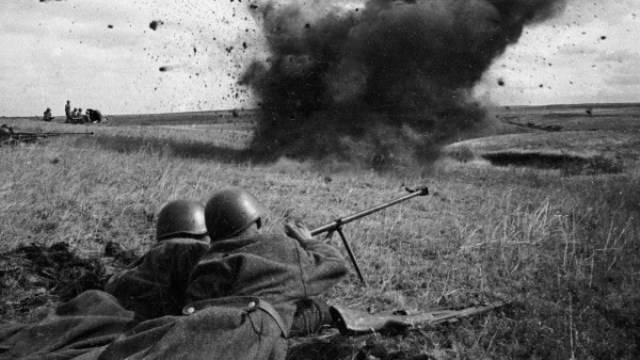
Almost immediately after appearing on the battlefield tanks the main means of dealing with them was artillery. At first, medium-caliber field guns were used to shoot tanks, but already at the end of World War I, specialized anti-tank artillery systems were created. In the 30s of the last century, 37-mm and 45-mm anti-tank guns were adopted in our country, and shortly before the war, guns with high armor penetration were created: the 57-mm anti-tank gun arr. 1941, which later became known as the ZIS-2, and 107-mm divisional cannon of the 1940 model (M-60). In addition, 76 mm divisional weapons available in the troops could be used to combat enemy tanks. In June 1941, the Red Army units were sufficiently saturated with 45-76-mm caliber guns, for that time they were quite advanced guns capable of penetrating the frontal armor of existing German tanks at real shooting distances. However, in the initial period of the war, due to heavy losses and loss of command and control, the Soviet infantry often found themselves on their own and fought with German means at hand.
The pre-war statutes and manuals provided for the use of hand fragmentation grenades obr.1914 / 30 and RGD-33 against tanks of bundles. In the Manual on Rifle Case 1935 of the year, it was prescribed to use several hand grenades to make a bundle of grenades. 1914 / 30. The grenades were tied together with string, telephone wire or wire, with four of them turned out to be turned handles in one direction, and the fifth - the middle, in the opposite direction. When throwing a bunch was taken by the handle of an average grenade. Located in the middle, it served to undermine the other four, thereby fulfilling the role of a detonator for the entire bundle.
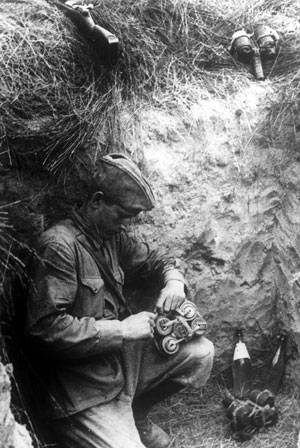
The main hand grenade of the Red Army to the 1941 year was the RGD-33 (Hand Grenade Dyakonov sample. 1933 of the year), developed on the basis of the Rdultovsky grenade 1914 / 30 of the year. Inside the warhead between the outer metal shell and the charge is a few turns of steel tape with cuts, which during the explosion gave a lot of light shards. To increase the fragmentation effect of a grenade, a special defensive shirt could be worn over the body. The weight of the grenade without a defensive shirt was 450 g, it was loaded with 140 g trotyl. In the offensive version, an explosion formed around 2000 splinters with a 5 m radius of continuous damage. The grenade throw range was 35-40 m. However, along with the good fragmentation effect, RGD-33 had an unsuccessful fuse that required rather complex preparation for use. For triggering the fuse, an energetic swing of the grenade was required, otherwise it was not transferred to the combat position.
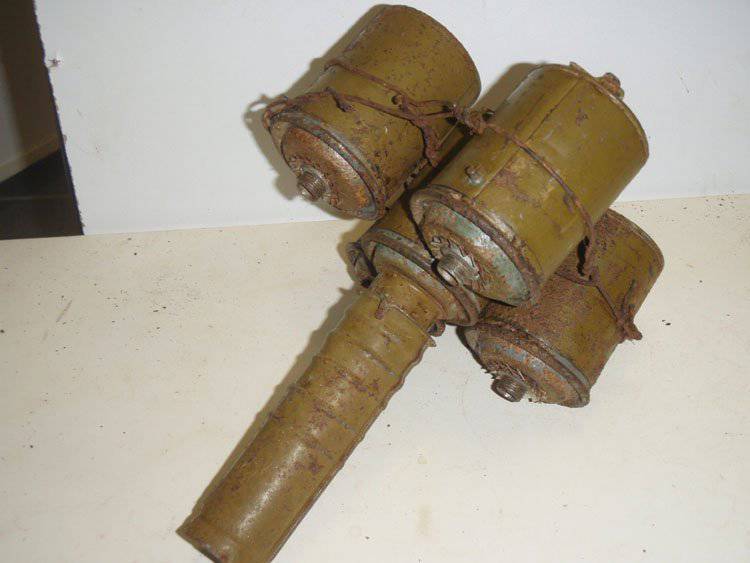
When using RGD-33 grenades, two to four grenades were attached to an average grenade, from which fragmentation shirts were preliminarily removed and the handles were unscrewed. Bundles were recommended to throw from the shelter under the tank tracks. Although in the second half of the war, the RGD-33 fragmentation hand grenade was replaced in the production with more advanced models, its use continued until the available reserves were consumed. A bunch of grenades were used by partisans until the liberation of the occupied territory by Soviet troops.
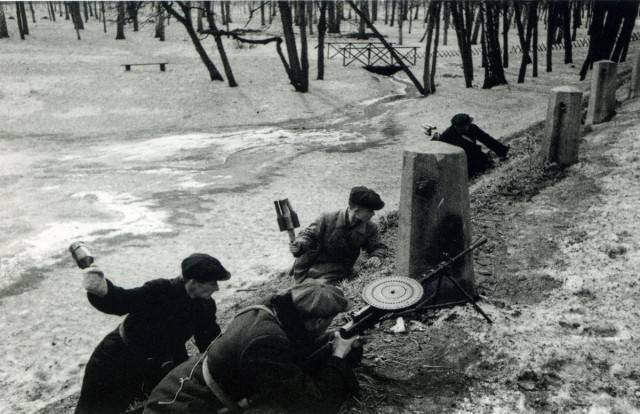
However, a more rational was the creation of a specialized high-explosive anti-tank grenade with a high coefficient of filling with explosive. In this regard, in the 1939, the designer of ammunition M.I. Bubble was designed anti-tank grenade, which received after the adoption in service in 1940, the designation RPG-40.
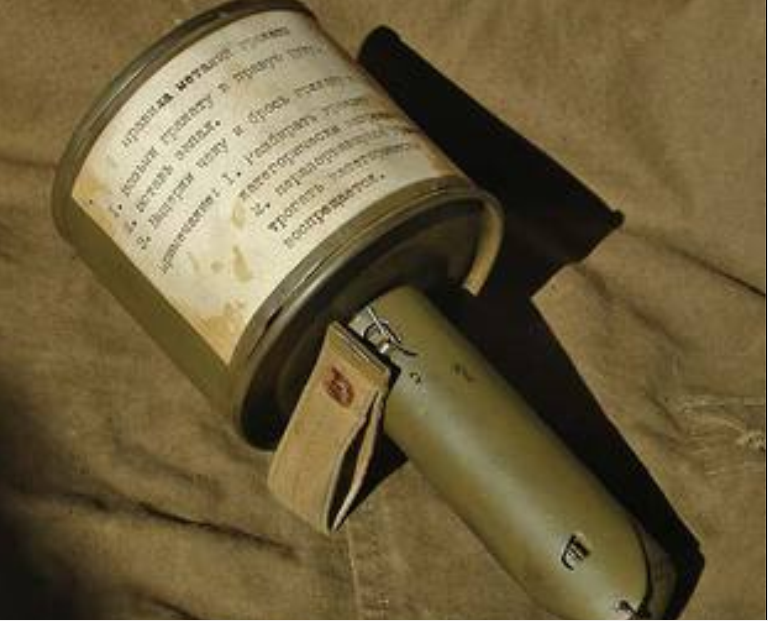
A grenade with a percussion fuse with a mass of 1200 g contained 760 g of TNT and was able to break through armor with a thickness of up to 20 mm. An inertial fuse with a percussion mechanism was placed in the handle, the same as in the RGD-33 fragmentation grenade. As in the case of frag grenade bundles, the safe use of RPG-40 was possible only from cover.
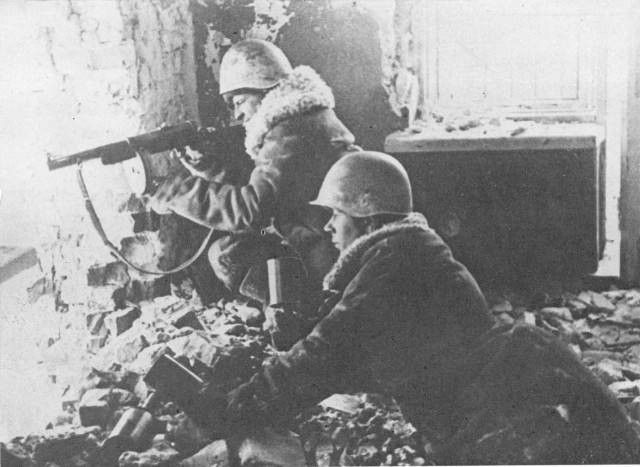
The massive release of the RPG-40 began after the start of the war. It soon became clear that it was effective enough only against light tanks. To disable the undercarriage of the tank, it was necessary to accurately throw a grenade under the caterpillar. Under blasting under the bottom of the Pz III Ausf.E 16 mm tank, the lower armor in most cases did not penetrate, and when thrown on the roof of the grenade body it often rebounded and rolled down before the trigger went off. In this regard, M.I. Bubble in 1941 created a more powerful RPG-41 grenade with 1400 g mass. Increasing the amount of explosives inside the thin-walled body made it possible to raise armor penetration to 25 mm. But due to the increase in the mass of the grenade, the range of the throw was reduced.
High-explosive anti-tank grenades and bundles of fragmentation grenades represented a great danger to those who used them, and the fighters often after a close explosion of their own anti-tank grenade died or received heavy contusions. In addition, the effectiveness of bundles RPG-40 and RPG-41 against tanks was relatively low, by and large, they were used for want of a better one. In addition to fighting with enemy equipment, anti-tank grenades were used against fortifications, as they had a large high-explosive effect.
In the second half of 1943, the RPG-43 manual cumulative grenades began to arrive in the army. The first in the USSR cumulative anti-tank grenade was developed by N.P. Belyakov and had a fairly simple design. The RPG-43 consisted of a body with a flat head, a wooden handle with a safety mechanism and a shock-detonating mechanism with a fuse. To stabilize the grenade after the throw was used ribbon stabilizer. Inside the case there is a charge of trotyl with a cumulative notch of conical shape, lined with a thin layer of metal, and a cup with a safety spring fixed in its bottom and sting.
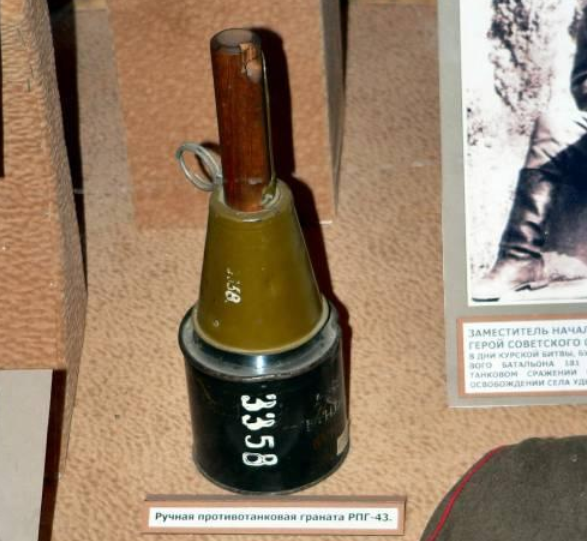
At the front end of the handle there is a metal sleeve inside which the holder is located and the pin that holds it in the rearmost position. Outside, a spring is put on the sleeve and fabric tapes are fastened to the stabilizer cap. The safety mechanism consists of a flap and checks. A folding bar serves to hold the stabilizer cap on the grenade handle until it is thrown, not allowing it to crawl or turn in place.
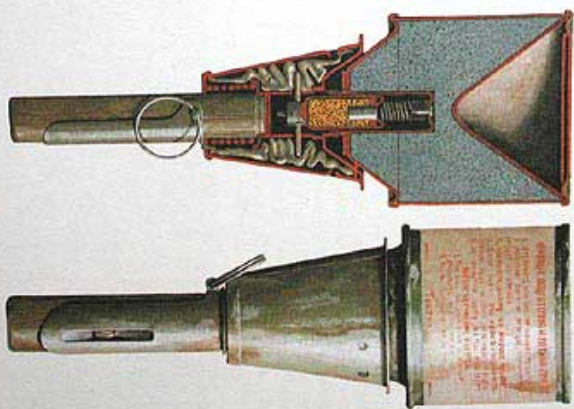
During the throw of the grenade, the flap is separated and releases the cap of the stabilizer, which, under the action of the spring, slides off the handle and pulls out the tape. The safety stud falls out under its own weight, freeing the holder of the fuse. Due to the presence of a stabilizer, the flight of a grenade took place head-first, which is necessary for the correct spatial orientation of the shaped charge relative to armor. When the grenade’s head strikes the obstacle, due to inertia, the fuse overcomes the resistance of the safety spring and imposes on the sting with a detonator cap, which causes the main charge to explode and form a cumulative jet capable of piercing an 75 mm armor plate. A grenade weighing 1,2 kg contained 612 g of TNT. A well-trained fighter could throw her on 15-20 m.
In the summer of 1943, the Pz.Kpfw.IV Ausf.H with the 80-mm frontal armor and onboard anti-cumulative steel screens became the main tank in Pantservaff. German medium tanks with heavy armor began to be massively used on the Soviet-German front at the start of the 1943. Due to the lack of armor of the RPG-43, a group of designers consisting of LB Ioffe, M.Z. Polevanova and N.S. Zhitkikh quickly created a cumulative RPG-6 grenade. Structurally, the grenade largely repeated the German PWM-1. Due to the fact that the mass of the RPG-6 was about 100 g less than that of the RPG-43, and the head part had a streamlined shape, the throw distance was up to 25 m. The best form of shaped charge and selection of the correct focal length, with increasing thickness of the pierced armor on 20-25 mm, it was possible to reduce the charge of TNT to 580 g, which, together with an increase in the throw range, reduced the risk for the grenade launcher.
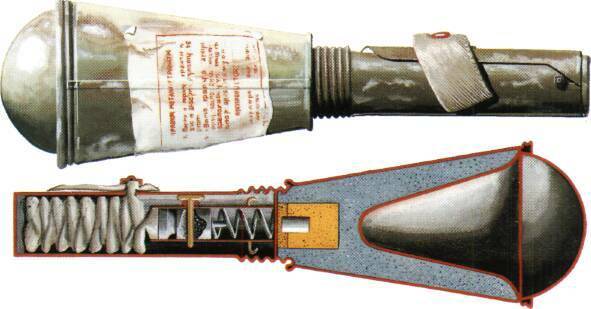
The grenade had a very simple and technological design, which allowed it to quickly start mass production and begin deliveries to the troops in November 1943 of the year. In the production of RPG-6 almost no lathes were used. Most of the parts were made by cold forging from sheet steel, and the thread was made by rolling. The body of the grenade was drop-shaped in which there was a shaped charge with a charge and an additional detonator. An inertial fuse with a detonator cap and a ribbon stabilizer was placed in the handle. Drummer fuse blocked check. The tapes of the stabilizer were laid in the handle and held by the safety bar. The safety pin was removed before the throw. After the throw, the escaping safety bar pulled out the stabilizer and pulled out the check of the drummer, after which the fuse was raised. In addition to greater armor penetration and better manufacturability of the RPG-6 compared to the RPG-43, it was safer because it had three degrees of protection. However, the production of RPG-43 and RPG-6 was conducted in parallel until the end of the war.
Along with bunches and anti-tank grenades, glass bottles with incendiary fluid were very widely used in the first half of the war. It is cheap, easy to use and at the same time very effective anti-tank weapon It was first widely used during the Spanish Civil War by the rebels of General Franco against republican tanks. Later, fuel bottles were used against the Soviet tanks by the Finns during the Winter War, who called them the Molotov Cocktail. In the Red Army they became the Molotov Cocktail. The leakage of burning fluid into the engine compartment of the tank, as a rule, led to a fire. In the event that the bottle broke on the frontal armor, the fire mixture most often did not get inside the tank. But the flames and smoke of the liquid burning on the armor obstructed observation, aimed fire, and had a strong moral and psychological effect on the crew.
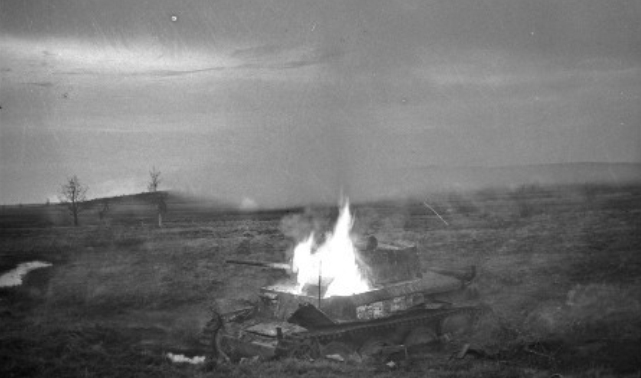
Initially, the equipment of the bottles with a flammable liquid was hand-crafted by the troops, and the various-sized beer and vodka bottles collected from the population were filled with gasoline or kerosene. In order for the flammable liquid not to spread very much, it burned longer and adhered better to the armor; improvised thickeners were added to it: tar, rosin or coal tar. A stopper made of tow was used as a fuse, which had to be set on fire before throwing the bottle into the tank. The need for pre-ignition fuse created certain inconveniences, besides, the equipped bottle with a stopper made of tow could not be stored for a long time, as the flammable liquid was actively evaporating.
7 July 1941, the State Defense Committee issued a decree "On anti-tank incendiary grenades (bottles)", which obliged the People's Commissariat of Food Industry to organize the equipment of glass bottles with mixture according to a specific recipe. Already in August, 1941 was equipped with incendiary bottles on an industrial scale. For filling the combustible mix consisting of gasoline, kerosene and ligroin was used.
On the sides of the bottle was attached 2-3 chemical fuses - glass ampoules with sulfuric acid, bertolet salt and icing sugar. After the impact, the ampoules broke and ignited the contents of the bottle. There was also an option with a fuse fuse, which was attached to the neck of the bottle. During the siege of the city, the Tula Arms Plant developed a rather complex fuse consisting of 4 pieces of wire, two ropes, a steel tube, a spring, and a pistol cartridge. The handling of the igniter was similar to the handling of the ignition for hand grenades, with the difference that the “bottle” igniter only worked when the bottle was broken.
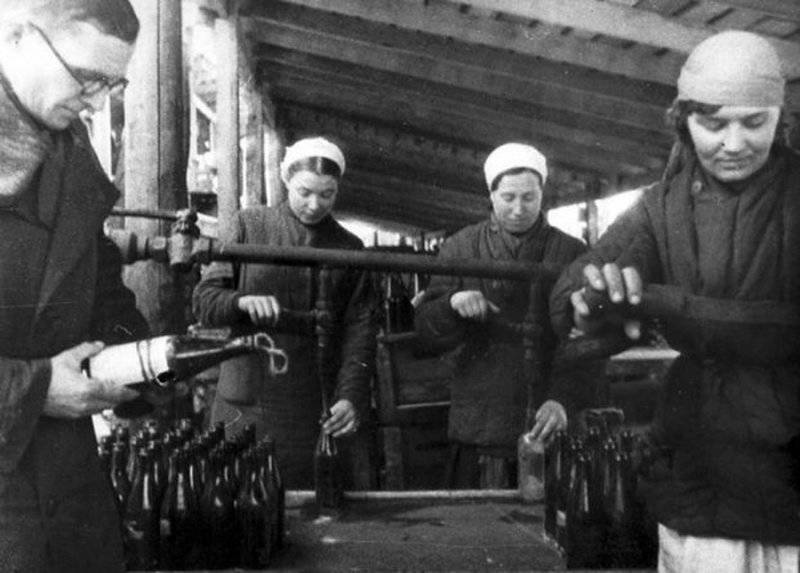
In the autumn of 1941, chemists A. Kachugin and P. Solodovnikov created a self-igniting liquid CS on the basis of a solution of white phosphorus in carbon disulfide. Initially, glass ampoules with a CC were attached to the sides of the incendiary bottle. At the end of the year, 1941 switched to filling the bottles with a self-igniting liquid. At the same time, winter and summer formulations, differing in viscosity and flash point, were developed. The CS liquid had a good incendiary ability in combination with an optimal burning time. When burning, thick smoke was emitted, and after burning a hardly washed out soot was left. That, when liquid hit the tank observation instruments and sights, they put them out of operation and made it impossible to conduct aimed fire and driving with the driver's hatch closed.
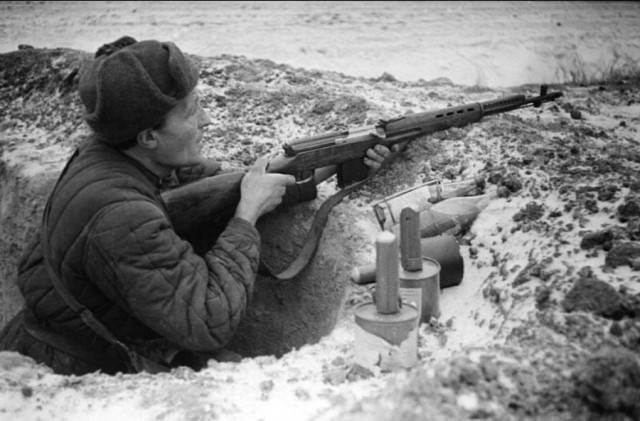
Like the anti-tank grenades, incendiary bottles were used, as they say, at close range. In addition, the best effect was obtained when the bottle was broken at the engine compartment of the tank, and for this the fighter in the trench had to miss the tank over himself.
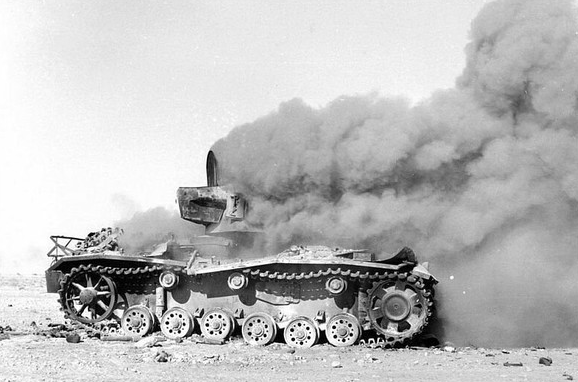
German tankers, having suffered sensitive losses from this inexpensive and fairly effective incendiary weapon, often reaching the line of Soviet trenches, began to spin, falling asleep alive to the Red Army soldiers hiding in them. To prevent the tanks from reaching our front-line line using incendiary bottles and a small amount of explosives, fire bombs were built in front of the trenches with an 10-15-area of destruction meters. When the tank hit the “bottle mine,” the fuse of the TNT 220 g checkers was set on fire, and the liquid KS was scattered around by an explosion.
In addition, special rifle mortars were created for throwing bottles at the COP. The most widespread bottle design VA. Zuckerman. The shot was made using a wooden wad and a blank cartridge. For shooting were taken bottles with thick glass. The target throwing distance of the bottle was 80 m, the maximum - 180 m, the rate of fire when calculating the 2 of a person - 6-8 rds / min.
The shooting compartment was given two such mortars. Shooting was carried out with the emphasis of the butt into the ground. However, the accuracy of shooting was low, and the bottles often broke up when fired. Due to the danger for calculations and low efficiency, this weapon has not found wide application.
In 1940, specialists of the design bureau of the plant No. 145 named after SM. Kirov was created 125-mm ampoule, originally intended for firing spherical tin or glass ampoules filled with toxic substances. In fact, it was a weapon for throwing small chemical munitions in a trench war. The sample passed field testing, but it was not accepted for service. They remembered about the ampulets when the Germans approached Leningrad, but they decided to shoot it with ampoules with liquid KS.
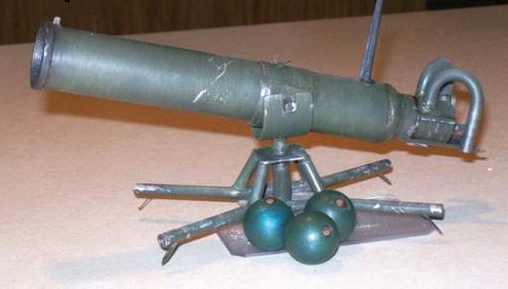
The ampoule was a low-ballistics muzzle-loading mortar, firing round thin-walled metal or glass ampoules with a self-igniting fire mixture. Constructively it was a very simple weapon consisting of a barrel with a chamber, a bolt, a simple aiming device and a gun carriage. Throwing the ampoule was carried out using a single-caliber 12 rifle cartridge. The aiming range of the ampule launcher was 120-150 m, when firing at a hinged trajectory with a large angle of elevation - 300-350 m. Rate of fire - 6-8 rds / min. Depending on the version, the mass of the ampule is 15-20 kg.

Along with such positive qualities as low cost of manufacture and simple construction, ampoulomas were quite dangerous to use. Often, during long shooting due to a large deposit, formed by black powder, which were loaded with 12 hunting caliber cartridges, the ampoules were destroyed, which was a danger to the calculation. In addition, the shooting accuracy was low, and getting into the frontal part of the tank did not lead to its destruction, although it blinded the crew. In addition to shooting at armored vehicles, ampoule guns were used to destroy and dazzle firing points and target illumination at night.
To destroy the enemy's manpower in the trenches, ampoules with a remote fuse were produced, which gave a break in the air. In some cases, glass ampoules with liquid KS were used as hand incendiary grenades. As the troops became more saturated and secure with anti-tank weapons, they refused to use bottlelets and ampoulomas. The longest ampoule guns fought in the trenches near Leningrad, up to the lifting of the blockade.
Another little known anti-tank weapon was the VKG-40 rifle cumulative grenade (1940 rifle cumulative grenade of the year), which was fired from a Dyakonov grenade launcher. The grenade launcher was a rifled mortar caliber 41-mm, with a special tube mounted on a Mosin rifle. For aiming grenade aiming-quadrant. A folding bipedal bipod and a plate were attached to the grenade launcher to rest the butt in soft ground.
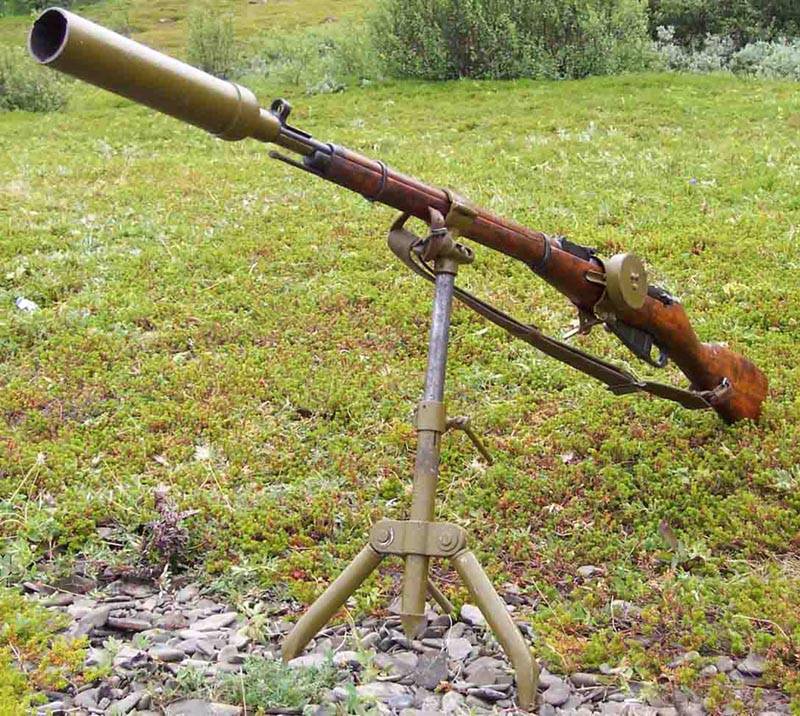
Grenade VKG-40 had a streamlined shape. In front of the unit was an explosive charge with a cumulative notch and metal lining. The inertial detonator was located in the tail of the grenade. When firing a grenade VKG-40 used blank cartridge with emphasis butt in the shoulder. For aiming it was possible to use the standard Mosin rifle sight. According to the reference data, the armor penetration capability of the VKG-40 grenade was 45-50-mm, which made it possible to hit the average German tanks Pz.Kpfw.III and Pz.Kpfw.IV into the board. However, the Dyakonov grenade launcher had serious flaws: the impossibility of firing a bullet without removing the mortar, a small range of an aimed shot and insufficient power.
In the autumn of 1941, the tests of the VGPS-41 shompolnogo rifle anti-tank grenade began. A grenade weighing 680 g was fired with a blank rifle cartridge. An unusual solution was the use of a moving stabilizer, which increased the accuracy of shooting. During transportation and preparation for firing, the stabilizer was in front of the ramrod. During the shot, the inertia stabilizer moved to the tail of the ramrod and stopped there.

Grenade caliber 60-mm and length 115 mm contained a charge of TNT mass of 334 g with a hemispherical notch in the head part, lined with a thin layer of copper. The inertial fuse in the bottom part in the stowed position was recorded by a safety check, which was removed immediately before the shot.
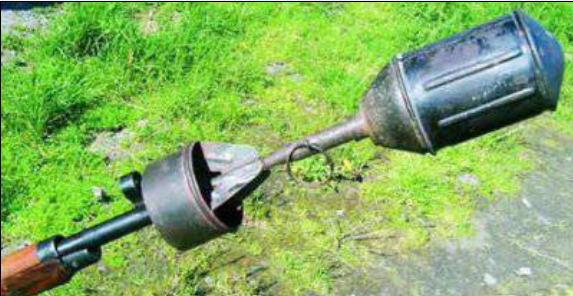
The range of aimed shooting was 50-60 m, for area targets - up to 140 m. Armor penetration along the normal - 35-mm. This was clearly not enough to break through the frontal armor of medium-sized German tanks. Serial production of VGPS-41 lasted until the spring of the 1942 year, after which the finished corps was used in the manufacture of a manual anti-personnel fragmentation grenade. To eliminate the cumulative effect that has become superfluous and to increase the filling ratio, the spherical funnel was pushed inside. In the warhead to increase the fragmentation action, a metal tape rolled into the 2-3 layer was inserted into the 0,7-1,2 mm thickness of a metal tape, the surface of which was cut with diamonds. The conical bottom of the VPGS-41 was replaced with a flat cap with a connecting sleeve into which the UZRG sunk was screwed.
Experiments with cumulative rifle grenades were not very successful. The aiming range of rifle grenades left much to be desired, and the penetrating ability of an imperfect warhead was low. In addition, the combat rate of fire of rifle grenade launchers was 2-3 rds / min, with very baggy loading.
Back in the years of the First World War, the first anti-tank guns were created. In the USSR, by the beginning of the war, despite successful tests in 1939, 14,5-mm PTR-39 designs by N.V. Rukavishnikov, there were no anti-tank guns in the troops. The reason for this was the incorrect assessment of the security of German tanks by the leadership of the People's Commissariat of Defense and, above all, by the head of the GAU, Kulik. Because of this, it was believed that not only anti-tank guns, but even 45-mm anti-tank guns would be powerless in front of them. As a result, the Soviet infantry was deprived of an effective anti-tank melee weapons, and being without the support of artillery, was forced to repel tank attacks with improvised means.
As a temporary measure in July 1941 year in the workshops MVTU them. Bauman established the assembly of anti-tank guns for 12,7-mm cartridge DShK. This weapon was a copy of the Mauser single-shot PTR of the First World War with the addition of a muzzle brake, a shock absorber on the butt and light folding bipods.
Weapons of this design at the beginning of 30-ies in small quantities were made at the Tula Arms Plant for the needs of NIPSVO (scientific testing ground for small arms), where rifles were used for testing 12,7-mm cartridges. The production of rifles in 1941 was set up at the suggestion of engineer V.N. Sholokhov and later on were often designated as 12,7 — a Sholokhov anti-tank rifle (ПТРШ-41).

The combat rate of fire of the PTRSh-41 did not exceed 6 rds / min. Weapons weighing 16,6 kg had a meter-high barrel in which an BS-41 armor-piercing incendiary bullet with a weight of 54 g with a tungsten alloy core was accelerated to 840 m / s. At a distance of 200 m such a bullet was able to pierce the normal 20 mm armor. But the troops usually used cartridges with B-32 armor-piercing incendiary bullets of mass 49 g with a hardened steel core, which could penetrate 250 mm armor at a distance of 16 m.
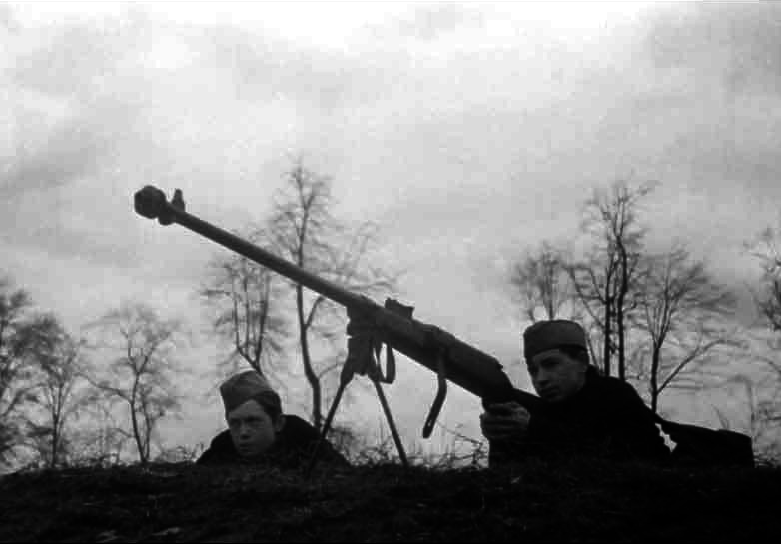
Naturally, with such indicators of armor penetration, Sholokhov's anti-tank gun could successfully fight only with light tanks Pz.Kpfw.I and Pz.Kpfw. II early modifications, as well as armored vehicles and armored personnel carriers. However, the production of the PTRSh-41 continued until the beginning of the 1942 of the year, and only the start of mass deliveries to the PTR troops under the 14,5-mm cartridge was curtailed.
In July 1941, I.V. Stalin demanded to speed up the creation of effective anti-tank guns and entrust the development of several well-known designers at once. The greatest success in this was achieved by V.A. Degtyarev and S.G. Simonov. New anti-guns were created in record time. In the fall of 1941, the single-charge PTRD-41 and the semi-automatic five-charge PTRS-41 were put into service. Due to the fact that the single-shot anti-tank gun Degtyarev was cheaper and easier to manufacture, it was possible to establish its mass production earlier. PTRD-41 was as simple and technologically advanced. In the fighting position, the gun weighed 17,5 kg. With a total length of 2000 mm, the barrel length with the chamber was 1350 mm. The effective firing range is up to 800 meters. Combat rate of fire - 8-10 rds / min. Battle calculation - two people.

The PTRD-41 had an open throw-over sight for two 400 and 1000 m distances. For carrying the gun for short distances when changing positions, a handle was worn on the barrel. The loading of weapons was carried out on one cartridge, but the automatic opening of the shutter after the shot increased the rate of fire. A high-performance muzzle brake served to compensate for recoil, and the back of the stock had a cushion. The first batch of 300 units was manufactured in October, and in early November she was sent to the army in the field.
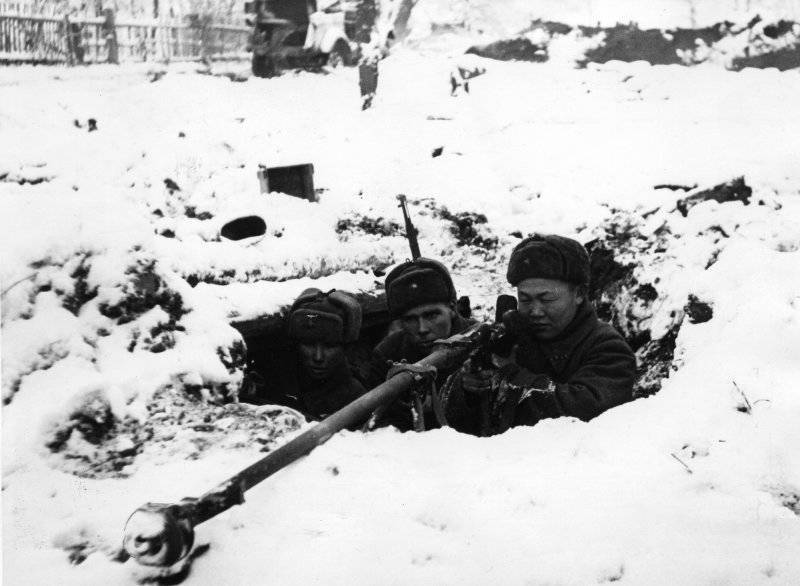
The Red Army soldiers of the 1075 Infantry Regiment of the Red Army 316 Infantry Division received the first anti-tank guns. In mid-November, the first enemy tanks were managed from the PTRD-41.
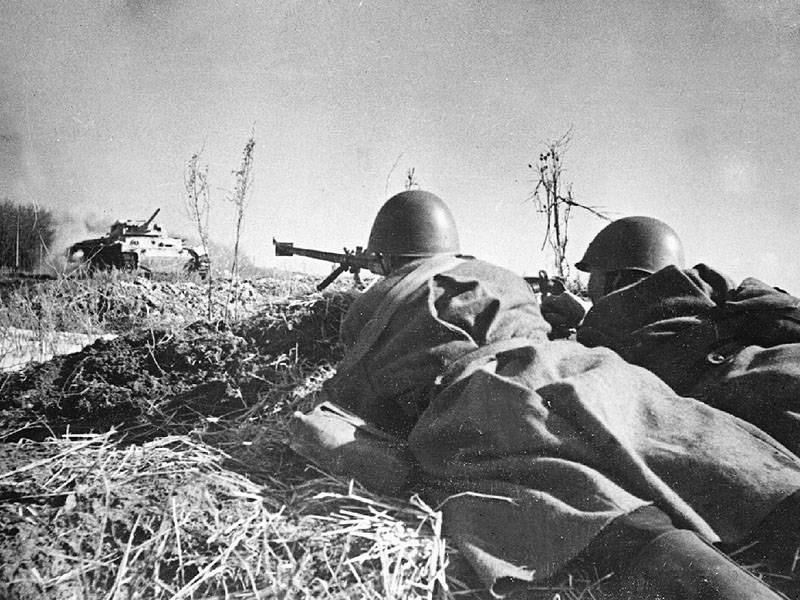
PTRD-41 production rates were actively increasing, by the end of the year 17 688 anti-tank guns of Degtyarev were delivered, and by January 1 1943 - 184 800 units. Production of PTRD-41 lasted until December 1944. A total of 281 111 single-shot anti-tank guns were released.
PTRS-41 operated according to the automation scheme with a powder gas discharge and had a magazine on 5 cartridges, and it was significantly heavier than Degtyarev's anti-tank gun. The mass of weapons in a combat position was 22 kg. However, Simonov's anti-tank gun had a combat rate of fire two times higher than the PTDD-41 - 15 rds / min.
Since the PTRS-41 was more complicated and more expensive than a single-shot PTRD-41, at first it was produced in small quantities. So, in 1941, the troops managed to surrender only 77 anti-tank guns Simonov. However, in 1942, the 63 308 unit was already produced. With the development of mass production, the cost of manufacturing and labor costs have been reduced. Thus, the cost of Simonov's anti-tank gun from the first half of 1942 to the second half of 1943 of the year decreased almost twice.
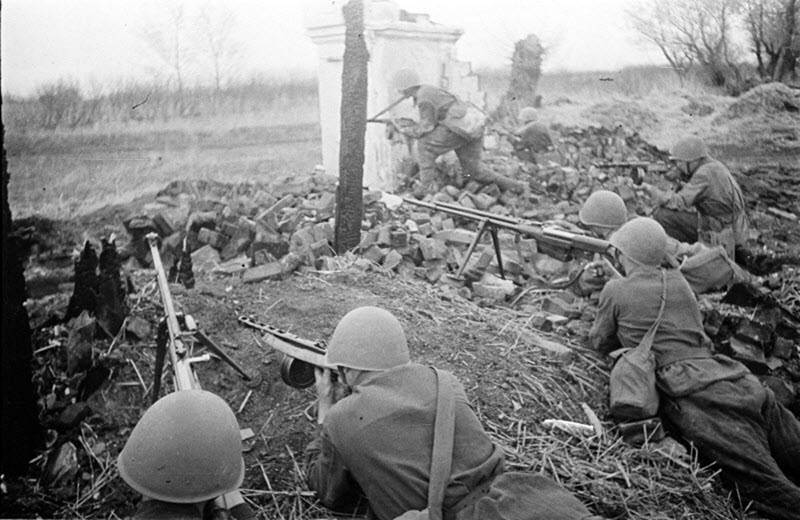
For firing of anti-tank guns designed by Dyagtyaryov and Simonov, 14,5x114 mm cartridges with BS-32, BS-39 and BS-41 armor-piercing incendiary bullets were used. The mass of the bullets was 62,6-66 g. Initial speed - The BS-32 and BS-39 bullets were used with a hardened core made of tool steel U12, U12XA, at a distance of 300 m their armor normal was 20-25 mm. The BS-41 bullet with a tungsten carbide core had the best penetrating ability. At a distance of 300 m she could penetrate 30 mm armor, and when shooting with 100 m - 40 mm. Also used ammunition with an armor-piercing incendiary tracer bullet, with a steel core, piercing with 200 m 25 mm armor.
In December, 1941 of the year, the company of PTR (according to 27, and later on 54 guns) was introduced into the newly formed regiments of rifle regiments. Since the fall of 1942, platoon of anti-tank guns have been introduced into infantry battalions. From January 1943, the company of PTR began to include a motorized rifle battalion of a tank brigade.
Until the second half of 1943, PTR played an important role in anti-tank defense. Given that the airborne armor of medium-sized German tanks Pz.Kpfw.IV and SAU, built on their base, was 30 mm, they were vulnerable to 14,5-mm bullets until the end of hostilities. However, even without punching the armor of heavy tanks, armored personnel carriers could create many problems for the German tank crews. Thus, according to the memoirs of the crews of the 503 heavy tank battalion who fought near Kursk on the Pz.Kpfw.VI Ausf.H1 tanks, as they approached the Soviet line of defense, heavy armor-piercing bullets sounded almost every second. The PTR calculations were often able to disable the surveillance devices, damage the gun, jam the turret, knock down the track and damage the chassis, thus depriving heavy tanks of combat capability. The targets for anti-tank guns were also armored personnel carriers and reconnaissance armored vehicles. The Soviet PTR, appearing at the end of 1941, was of great importance in anti-tank defense, eliminating the gap between the anti-tank capabilities of artillery and infantry. At the same time, it was a front-line weapon, calculations of anti-tank guns suffered significant losses. During the war years, 214 000 PTR of all models was lost, that is, 45,4% of troops received. The largest percentage of losses was observed in 1941-1942 years - 49,7 and 33,7%, respectively. Losses of the material part corresponded to the level of losses among the personnel. The presence of anti-tank guns in the infantry units allowed them to significantly increase their resistance in defense and, to a large extent, get rid of the "tank attack".
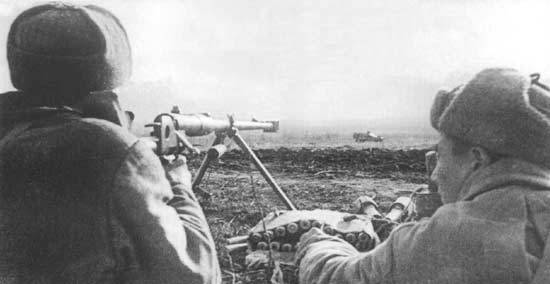
From the middle of 1942, the MFR took a firm place in the air defense system of the Soviet front edge, compensating for the lack of small-caliber anti-aircraft guns and large-caliber machine guns. For shooting at the planes it was recommended to use armor-piercing, incendiary tracer bullets.
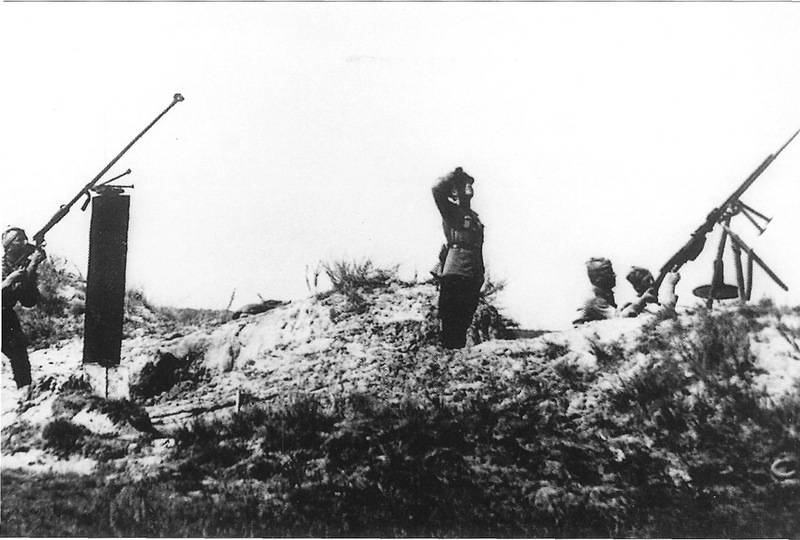
For firing at planes, the five-charge PTRS-41 was more suitable when shooting, from which it was possible to quickly make an amendment in case of a miss. Anti-tank rifles were popular among Soviet partisans, with their help they smashed German truck columns and blew steam boilers. The production of anti-tank guns was completed at the beginning of 1944 of the year, by which time the front edge of our troops was saturated with a sufficient number of anti-tank artillery. Nevertheless, anti-tank guns were actively used in combat until the last days of the war. They were in demand in street battles. Heavy armor-piercing bullets pierced the brick walls of buildings and barricades of sandbags. Very often, the PTR was used for firing at embrasures of bunkers and billets.
During the war years, the Red Army had the opportunity to compare the Soviet PTR and the British 13,9 anti-tank rifle - mm Boys, and the comparison turned out to be very much against the English model.
The British five-shot anti-tank rifle with a longitudinally sliding gate weighed 16, 7 kg - that is a little less than the 14,5-mm PTRD-41, but was much inferior to the Soviet PTR on armor penetration. At a distance of 100 m at an angle of 90 °, a W Mk.1 bullet with a steel core weighing 60 g, ejected from a barrel of 910 mm length with a speed of 747 m / s, could penetrate an 17 mm armor plate. The 12,7-mm Sholokhov anti-tank gun had about the same armor penetration. In the case of using a W Mk.2 bullet with a mass of 47,6 g with an initial speed of 884 m / s, an armor with a thickness of 100 mm could be broken along the normal range of 25 m. Such indicators of armor penetration when using cartridges with a steel core were used by Soviet MTRs at a distance of 300 m. Because of this, the British Boyres MTR in the Red Army did not use popularity and were used mainly in secondary areas and in rear units.
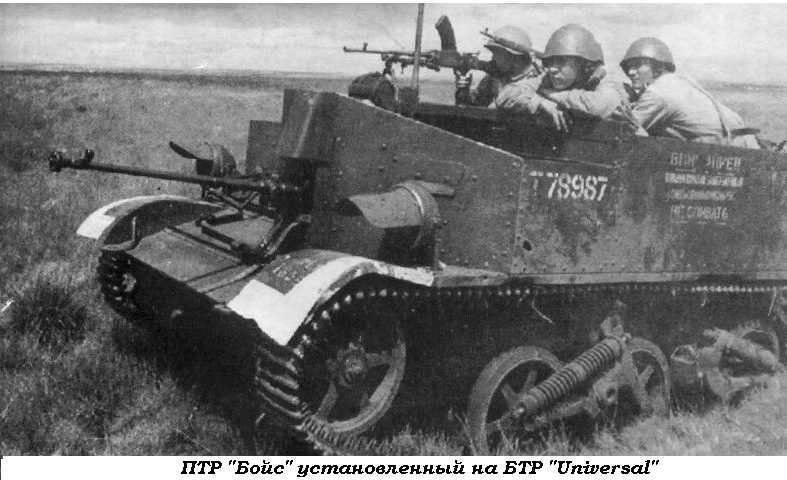
In addition to the infantry version, the 13,9-mm PTR was installed on the reconnaissance version of the BTR "Universal" - "Scout Carrier". In total, 1100 "Boys" was sent to the USSR.
Already in the middle of 1943, it became clear that the armament-carrying PTRs were not able to effectively deal with German heavy tanks. Attempts to create larger-caliber anti-tank guns have demonstrated the futility of this direction. With a significant increase in weight to obtain the characteristics of armor penetration, guaranteeing penetration of frontal armor, even medium tanks failed. The creation of light anti-tank weapons, which fired a jet feathered cumulative projectile, looked much more attractive. In the middle of 1944, the tests of the reusable RPG-1 anti-tank grenade began. This weapon was created by specialists of the Research and Development Range of Mortar Weapons of the GRAU under the guidance of the leading designer GP. Lominsky.
On tests RPG-1 showed good results. The range of a direct shot of an 70-mm over-caliber cumulative muzzle-loading grenade was 50 meters. A grenade weighing about 1,5 kg at right angles punched 150 mm homogeneous armor. Stabilization of a grenade in flight was carried out by a rigid feather stabilizer that opened after exiting the barrel. The grenade launcher with a length of about 1 m weighed a little over 2 kg and had a fairly simple design. On the 30-mm barrel, a trigger type trigger with a pistol grip, an aiming bar and wooden thermal protective pads were mounted. The top edge of the grenade when aiming served as a front sight. As a propellant charge was used paper cylinder, equipped with black powder, which gave a thick cloud of well-visible white smoke when fired.
However, the fine-tuning of the RPG-1 was delayed, because for several months it was not possible to achieve stable operation of the fuse. In addition, the propellant charge absorbed water and refused to wet weather. All this led to the fact that the military lost interest in the grenade launcher, when it became clear that they would succeed in victoriously ending the war in the near future without the RPG-1. Thus, during the war in the USSR, anti-tank grenade launchers, similar to the German Panzerfaust or the American Bazooka, were never created.
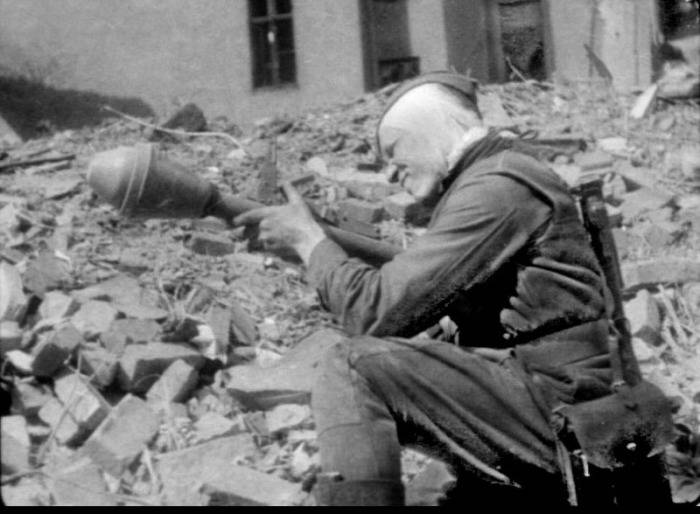
In part, the lack of specialized anti-tank grenade launchers in the Red Army was offset by the widespread use of captured German grenade launchers, which were very widely used by our foot soldiers. In addition, German tanks at the final stage of hostilities were mainly used as a mobile anti-tank reserve, and if they went on the attack to our front line, they were usually destroyed by anti-tank artillery and assault aviation.
Продолжение следует ...
Based on:
http://warbook.info/item/protivotankovaya-granata-rpg-40-i-rpg-41
https://www.yaplakal.com/forum2/topic1239962.html
http://warbook.info/item/obzor-butylkometa-tsukermana
http://russian7.ru/post/ampulomet-gde-primenyali-universaln/
http://www.sinopa.ee/sor/bo001/bo05sv/bo05sv12/ptrd001.htm
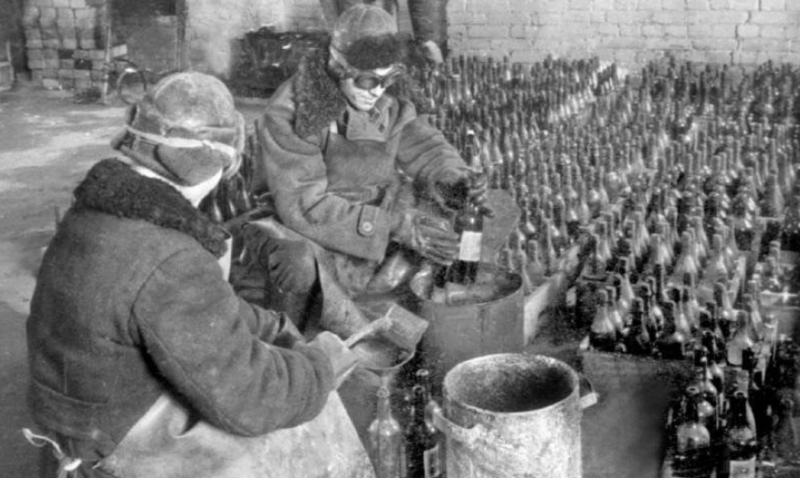

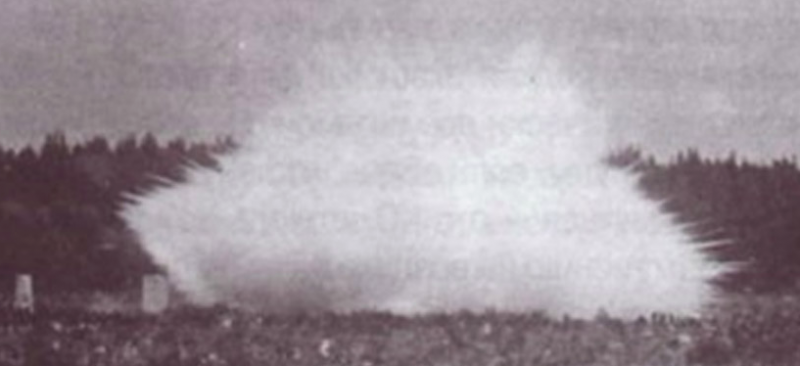

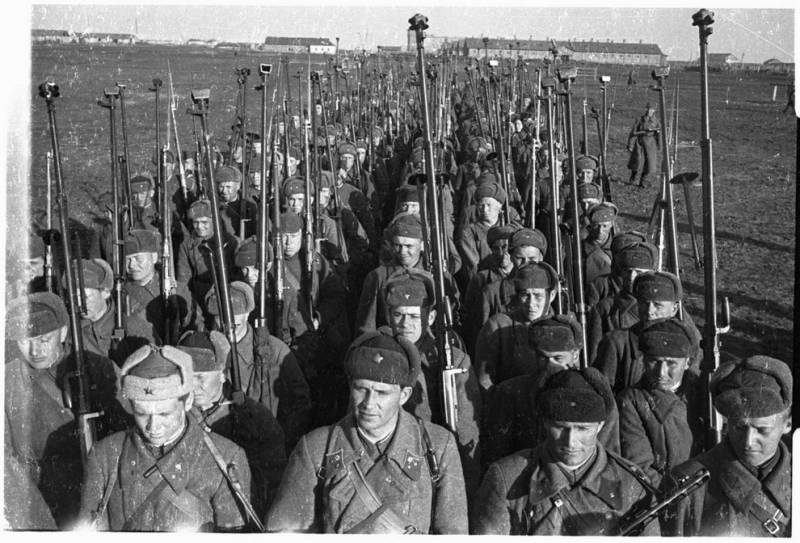
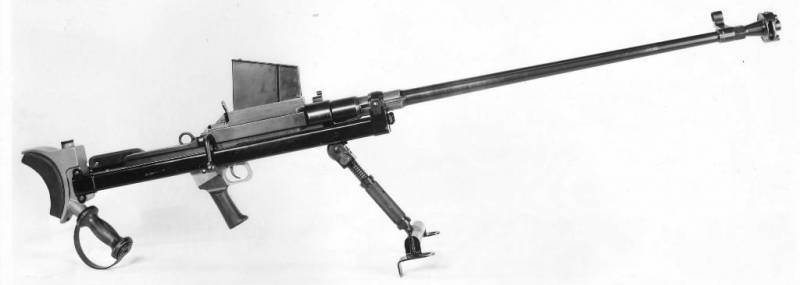
Information